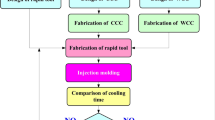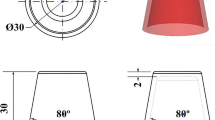Abstract
The service life of hot forging molds is seriously reduced under high-temperature load for a long time. Arc-directed energy deposition (ADED) high-precision hot forging mold cavity with conformal cooling channels (HFMCCC) in the mold cavity, reducing the working temperature of the mold and forming an isothermal field is an effective method to improve the life of hot forging mold. Based on the space-curved surface structure of HFMCCC, the manufacturing partition strategy of which is studied. In order to avoid interference of the arc torch in the process of manufacturing the joint of the left and right sub-areas and corner of the CCC, combined with the depth of the cavity, the U-shape, and the quadrilateral structure inside the hot forging mold, it is divided into four regions: the transition region and the upper, middle, and lower regions. The path planning strategy of offset filling is applied to the transition region; scanning composite offset filling is applied to regions containing U-shaped and quadrilateral features, and an arc torch with contour-varying posture is applied to CCC regions. The visual interference and posture optimization of the printing path are carried out by using simulation software, and the printing path robot instructions in four areas are obtained. ADED the hot forging model cavity of the double-layer space curved conformal channel. The forming accuracy of CCC is 0.568 mm, and the average deviation of HFMCCC is 0.713 mm. Under the same working conditions, the temperature gradient field of the conformal channel mold is 5 ℃/cm, while the temperature gradient field of the traditional linear channel is 12 ℃/cm. The temperature gradient field difference of the conformal channel mold is 7 ℃/cm smaller than that of the traditional straight channel mold.


















Similar content being viewed by others
Data availability
The data can be provided by the corresponding author under reasonable requirements.
References
Xia JC, Hu HB, Zhao HT, Deng QW, Deng L, Li ZW, Yu SF (2020) Development and application on 3D printing manufacturing and remanufacturing technology and equipment for hot forging mold. Forging Stamping Technol 45(8):1–5
Yin BW, Fan LX, Yang C, Yang YZ (2021) Radial springback and dimensional accuracy research of barrel in precision forging. J Ordnance Equipment Eng 42(01):78–84
Zhou MT, Yang C, Fan LX, Zhang BL, Chen XP (2021) Research on influencing factors and judgment criterion of cracking defects in sinking section of the barrel forged with chamber and rifled bore. J Ordnance Equipment Eng 42(11):102–108
Jiang J, Wang XY, Deng L, Li JJ, Li PC (2021) Study on local flow-controlled die forging technology for landing gear outer tube forging. J Ordnance Equipment Eng 42(02):239–243 (260)
Karbasian H, Tekkaya AE (2010) A review on hot stamping. J Mater Process Tech 210(15):2103–2118
Agazzi A, Sobotka V, LeGoff R, Jarny Y (2013) Uniform cooling and part warpage reduction in injection molding thanks to the design of an effective cooling system. Key Eng Mater 554–557:1611–1618
Hsu FH, Wang K, Huang CT, Chang RY (2013) Investigation on conformal cooling system design in injection molding. Adv Prod Eng Manag 8(2):107–115
Shi YS, Wu ZG, Wei QS, Huang SH (2007) Effects of conformal cooling channel on injection molding and production efficiency. J Huazhong Univ Sci Technol Nat Sci 35(3):60–62
Zhang C, Wang S, Li J, Zhu Y, Peng T, Yang HY (2020) Additive manufacturing of products with functional fluid channels: a review. Additive Manuf 36:101490
Muvunzi R, Dimitrov DM, Matope S, Harms T (2021) A case study on the design of a hot stamping tool with conformal cooling channels. Int J Adv Manuf Technol 114:1833–1846
Oh SH, Ha JW, Park K (2022) Adaptive conformal cooling of injection molds using additively manufactured TPMS structures. Polymers 14:181
Ilyas I, Taylor C, Dalgarno K, Gosden J (2010) Design and manufacture of injection mould tool inserts produced using indirect SLS and machining processes. Rapid Prototyp J 16(6):429–440
Yang Y, Hannula SP (2008) Development of precision spray forming for rapid tooling. Mater Sci Eng A 477(1–2):63–68
Liu FC, Fan ZT, Liu XW, He JQ, Li FG (2016) Aqueous gel casting of water-soluble calcia-based ceramic core for investment casting using epoxy resin as a binder. Int J Adv Manuf Technol 86(5–8):1235–1242
Taylor CM, Ilyas IP, Dalgarno KW, Gosden J (2007) Manufacture of production quality injection mold tools using SLS and HSM. In: Proceedings of the ASME International Manufacturing Science and Engineering Conference. ASME, Atlanta Georgia, pp 9–16
Zhang ZY, Joshi S (2015) An improved slicing algorithm with efficient contour construction using STL files. Int J Adv Manuf Technol 80(5–8):1347–1362
Ferreira S, Bruns R, Ferreira H et al (2007) Box-Behnken design: an alternative for the optimization of analytical methods. Anal Chim Acta 597(2):179–186
Jin GQ, Li WD, Gao L (2013) An adaptive process planning approach of rapid prototyping and manufacturing. Robot Comput Integr Manuf 29(1):23–38
Lei CR, Ge ZH, Wei LL, Chen H (2021) Review of 3D printing model slicing and path planning research. Comput Eng Appl 57(3):24–32
Ding DH, Pan ZX, Cuiuri D, Li HJ, Larkin N (2016) Adaptive path planning for wire-feed additive manufacturing using medial axis transformation. J Clean Prod 133:942–952
Karunakaran KP, Suryakumar S, Pushpa V, Akula S (2010) Low cost integration of additive and subtractive processes for hybrid layered manufacturing. Robot Comput Integr Manuf: Int J Manuf Product Process Dev 26(5):490–499
Kazanas P, Deherkar P, Almeida P, Lockett P, Williams S (2012) Fabrication of geometrical features using wire and arc additive manufacture. Proc Inst Mech Eng B J Eng Manuf 226(6):1042–1051
Yuan L, Pan ZX, Ding DH et al (2020) Investigation of humping phenomenon for the multi-directional robotic wire and arc additive manufacturing. Robot Comput Integr Manuf 63:101916
Yang Y, Fuh JY, Loh HT, Wong YS (2003) Multi-orientational deposition to minimize support in the layered manufacturing process. J Manuf Syst 22(2):116–129
Craig JJ (2006) Introduction to robotics mechanics and control. Pearson, New York
Funding
This work was supported by the National Key R&D Program of China, No.2017YFB1103200.
Author information
Authors and Affiliations
Contributions
All authors have contributed to the development of the research and to the elaboration of this paper.
Haitao Lin: investigation, formal analysis, data curation, writing and editing the original draft.
Shengfu Yu: writing-review and editing, supervision, and funding acquisition.
Runzhen Yu and Bo Zheng: resources and data curation.
Corresponding author
Ethics declarations
Ethical approval
There are no ethical issues in this paper.
Consent to participate
Written informed consent for publication was obtained from all participants.
Consent for publication
No conflict of interest exists in the submission of this manuscript, and the manuscript is approved by all authors for publication.
Competing interests
The authors declare no competing interests.
Additional information
Publisher's note
Springer Nature remains neutral with regard to jurisdictional claims in published maps and institutional affiliations.
Rights and permissions
Springer Nature or its licensor (e.g. a society or other partner) holds exclusive rights to this article under a publishing agreement with the author(s) or other rightsholder(s); author self-archiving of the accepted manuscript version of this article is solely governed by the terms of such publishing agreement and applicable law.
About this article
Cite this article
Lin, H., Yu, S., Yu, R. et al. Arc-directed energy deposition for hot forging mold cavity with conformal cooling channels. Int J Adv Manuf Technol 125, 4453–4466 (2023). https://doi.org/10.1007/s00170-023-10844-0
Received:
Accepted:
Published:
Issue Date:
DOI: https://doi.org/10.1007/s00170-023-10844-0




